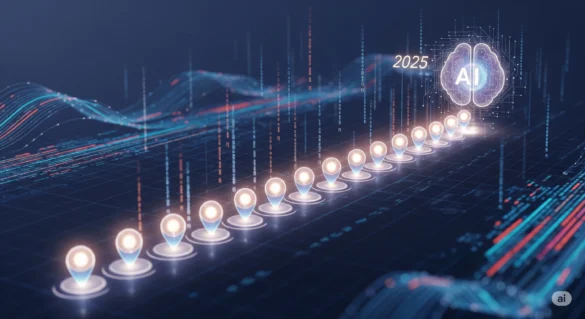13-Step AI Roadmap 2025
Ready to transform from a curious ChatGPT user into a confident AI practitioner? Follow this step-by-step guide—13 essential steps—to learn AI from scratch, leveraging both no-code tools and coding frameworks. Let’s jump in!
Step 1: Why do you want to learn AI? – The Foundation of Your AI Roadmap
Before you dive into the technicalities, the most crucial first step is to answer a fundamental question: Why do you want to learn AI? Your motivation will be the compass that guides your entire learning journey, determining its depth, focus, and ultimate outcome.
Casual User vs. Career Aspirant
- Casual User: You want to be more confident with AI platforms (ChatGPT, Gemini, Midjourney).
- Approach: Read online guides, watch tutorials, experiment with tools.
- Outcome: Efficiency gains, but fewer career impacts.
- Career-Oriented: You aim for a professional AI role (engineer, data scientist, product manager).
- Approach: Master coding fundamentals, data science, and ML.
- Outcome: Access to high-paying AI jobs (e.g., AI Engineer: $200–250K; Policy Analyst: $140K+) and 170M new AI roles by 2030 (WEF Report).
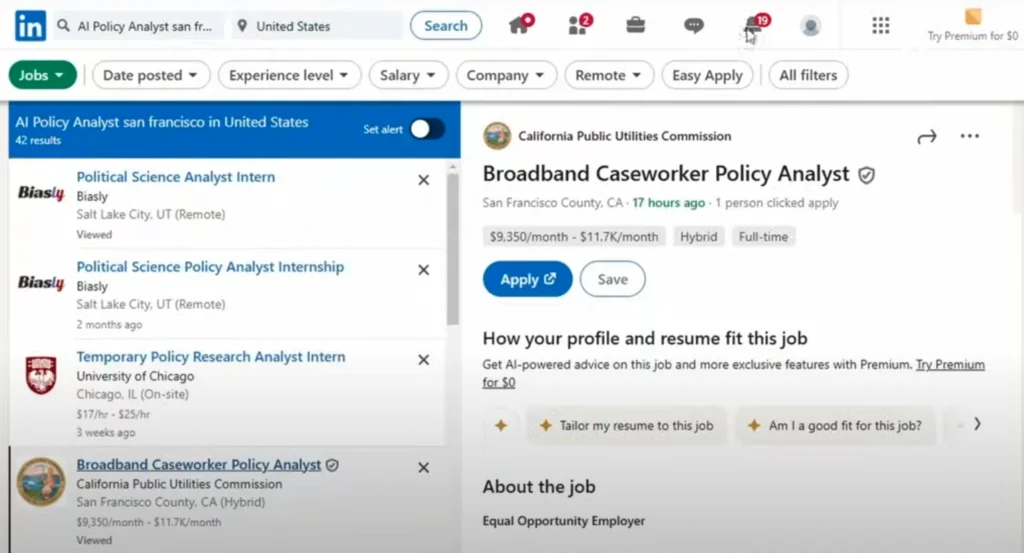
AI Jobs in Linkedin — Policy Analyst
Your “why” directly dictates the difficulty and focus of your learning. A clear purpose ensures you pick the right learning path, aligning your effort with your ultimate ambitions and maximizing your learning efficiency.
Step 2: Understand the Booming AI Job Market
The urgency of learning AI is underscored by its profound impact on the global job market. The World Economic Forum’s 2025 job report paints a clear picture: while an estimated 92 million jobs will be displaced by 2030 due to automation, a staggering 170 million new jobs will be created, with AI and Big Data at the forefront. This isn’t just a trend; it’s a massive economic shift. source
High-Paying Opportunities Await
A quick glance at current job listings confirms the demand. Searching for “artificial intelligence” roles in the US with salaries exceeding $120,000 reveals over 15,000 results. Here’s a glimpse of the lucrative positions available:
| Job Title | Approximate Annual Salary Range |
| Lead AI Engineer | $200,000 – $250,000 |
| Research Engineer (Google) | $100,000 – $200,000 |
| AI Policy Analyst | $140,000+ |
| Product Manager for AI Projects | $160,000+ |
Step 3: Set Realistic Expectations – How Long Does it Take to Learn AI?
Learning Timelines Based on Background
The time commitment for learning AI varies significantly based on your existing technical background and your learning goals. There’s no one-size-fits-all answer, but we can set some realistic benchmarks.
| Background | Time to AI Fundamentals |
| You already code | Weeks to 1 month |
| You only prompt-type in ChatGPT | 2–3 months |
| You just want prompt engineering | 1 day–1 week |
| You want advanced skills | ~1 year (part-time study) |
| You choose a university program | 3–4 years |
Prior programming knowledge significantly accelerates AI skill acquisition, as many AI tools and concepts are deeply rooted in code.
Casual users, aiming for prompt engineering or tool utilization, require less technical overhead. Self-learning, when focused, allows you to directly target the skills your dream job requires, skipping irrelevant material in this fast-evolving field. source
Step 4: Deconstruct AI’s Scope: AI, ML, Deep Learning, and Data Science
The AI Concept Hierarchy Explained
Many people mistakenly view AI as a single, monolithic “mega-technology.” In reality, Artificial Intelligence is a broad umbrella term encompassing several specialized and interconnected sub-fields. Understanding this hierarchy is crucial for choosing your specialization.
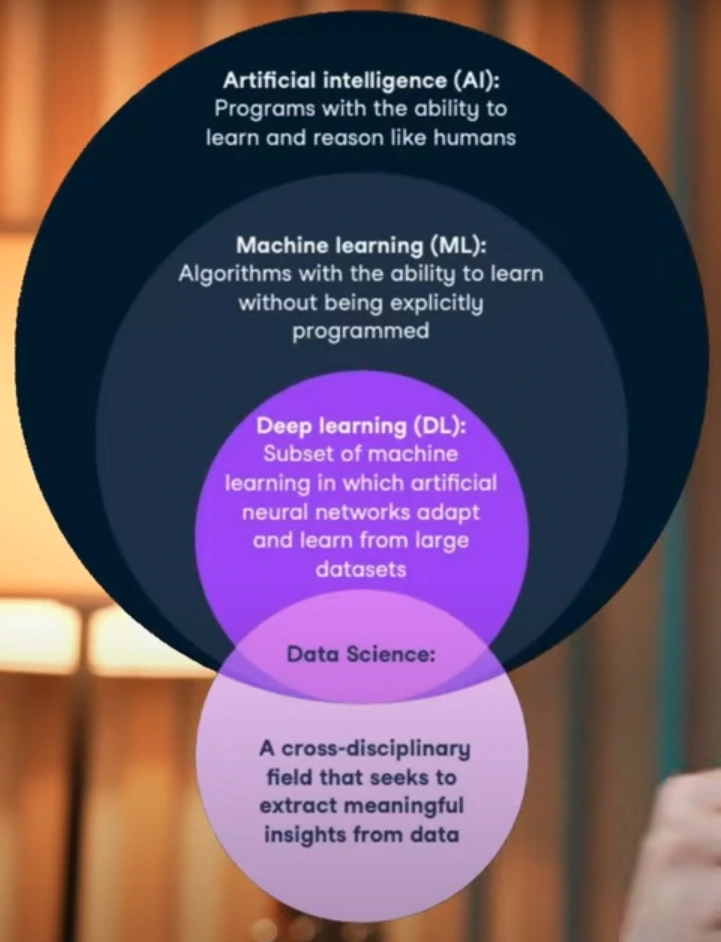
- Artificial Intelligence (AI): At the very top, AI is the broadest field focused on building systems that can mimic human cognitive functions – reasoning, problem-solving, decision-making, and learning. This is the overarching goal of creating intelligent machines. source
- Machine Learning (ML): A core subset of AI, ML focuses on enabling computers to “learn” from data without being explicitly programmed for every task. Instead, algorithms are trained on vast datasets to identify patterns and make predictions or decisions. Think of Netflix recommending your next binge-watch based on your viewing history – that’s ML at work. source
- Deep Learning (DL): This is a specialized subset of Machine Learning. Deep Learning models are inspired by the structure and function of the human brain’s neural networks. They use multiple layers to process complex data such as images, speech, and natural language. Technologies like facial recognition and Large Language Models (LLMs) such as ChatGPT are powered by Deep Learning. source
- Data Science: While often intertwined with AI and ML, Data Science is a broader, multidisciplinary field. Data scientists leverage various tools, techniques, and algorithms (which may include AI/ML or even basic statistics) to extract knowledge and insights from structured and unstructured data. Their goal is to solve problems, drive decision-making, and uncover hidden patterns. source
Understanding this hierarchy allows you to strategize your learning path effectively. You can start with broad AI concepts, then narrow down to Machine Learning, and eventually dive into Deep Learning if your interests align. Data Science, with its comprehensive approach to data, is often a strong foundation or a specialized career path in itself.
Step 5: Choose Your Path: Coding vs. No-Code Learning
The “Catch Your Own Fish” Analogy
One of the most significant decisions on your AI roadmap is whether to embrace a coding-intensive approach or opt for the more accessible no-code tools. Each has its distinct advantages and limitations.
Pros & Cons
| Approach | Pros | Cons |
| No-Code | Quick start; visual tools; easy prompts | Limited customization; service-locked |
| Coding | Full control; build/tune models | Steeper learning curve; more setup |
Recommendation for AI Beginners — AI Roadmap 2025
- Studying how others structure their prompts and refine their outputs, and understanding the capabilities of various no-code tools.
- If you choose the coding route, Python is your best first step. It’s incredibly beginner-friendly, has clean syntax, runs on virtually any operating system (even in your web browser!), and boasts an enormous, supportive community. Python also has a giant ecosystem of free libraries and frameworks like TensorFlow and PyTorch, which are essential for building and training machine learning models.
Step 6: Master Essential Tools: Python, GitHub, and Frameworks
Your AI Developer Toolkit — AI Roadmap 2025
For those embarking on the coding journey, proficiency with specific tools is non-negotiable. These are the building blocks of modern AI development.
- Python Programming Language:
As mentioned, Python is the lingua franca of AI. Beyond just writing code, understanding its idiomatic usage and leveraging its extensive standard library is key.
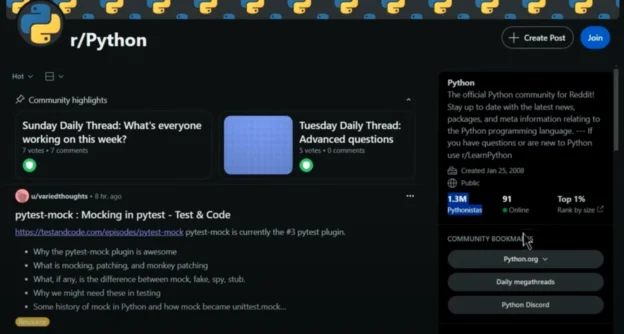
- GitHub (Version Control):
Think of GitHub as the global meeting place and collaborative workspace for developers. It’s not just a website; it’s a powerful version control system that helps you track every change you make to your code. source
- Why it’s crucial: You can find everything from small code snippets to massive AI models and entire pipelines. Exploring these repositories is a fantastic way to learn by example.
- Career Impact: Your GitHub profile essentially becomes your coding resume, showcasing your projects and contributions to potential employers.
- Key Skills: Learn how to make commits, create branches for parallel development, and collaborate through pull requests. Many free tutorials on YouTube can help you get comfortable.
- Machine Learning Frameworks (TensorFlow, PyTorch, scikit-learn):
These are pre-built libraries that simplify the process of building, training, and deploying AI models. They provide optimized functions and structures, saving you immense time and effort. TensorFlow and PyTorch are the industry leaders for deep learning, while scikit-learn is excellent for traditional machine learning algorithms. source
Step 7: Learn AI Effectively: Reverse Engineering and Hands-On Practice
Dissecting and Rebuilding Projects
Passive learning, while a starting point, won’t make you an AI master. To truly internalize concepts and develop problem-solving skills, you need to get your hands dirty.
1.The Power of Reverse Engineering:
This is arguably the most important skill you can develop. It involves downloading existing AI or ML projects that align with your interests and are slightly above your current skill level. Then, you “peel back the layers” to understand how everything is put together.
- Process: Dig into the source code, identify what each function or class does, understand the data flow, and then try to modify or even piece it back together in your own way.
2.Hands-On Practice
Don’t just watch tutorials; follow along and replicate the code. The more you code and experiment, the more comfortable you’ll become. Even seemingly small coding exercises contribute significantly to your confidence and problem-solving abilities.
3.For No-Code Users
The principle of reverse engineering still applies. Instead of code, you’ll be dissecting how other users structure their prompts, refine their outputs, and chain different AI tools together to achieve complex results.
Active engagement with real projects fosters a much deeper comprehension and builds practical confidence that theoretical knowledge alone cannot provide. source
Step 8: Start with Large Language Models (LLMs) — AI Roadmap 2025
Understanding and Applying LLMs
Large Language Models (LLMs) are an excellent entry point into modern AI, primarily because many of us have already interacted with them (e.g., ChatGPT, Gemini). This familiarity can make the learning curve surprisingly manageable.
- Conceptual Understanding: Begin by understanding the core architecture behind LLMs. A highly recommended starting point is watching Andrej Karpathy’s hour-long video on LLMs. He breaks down complex topics like Transformer models in an incredibly accessible way, giving you a solid foundation for how these powerful models are built.
- Practical Application (APIs): Once you grasp the concepts, move on to experimenting with various LLM APIs.
- OpenAI’s GPT-4o: This is a top contender, offering a wealth of features, including an Assistant API that behaves like an agent and a real-time API for quick text or audio responses. Be mindful of their billing structure, and consider leveraging community forums for smoother onboarding.
- Other LLM Providers: Explore models from Google (Gemini API), Anthropic (Claude), and others to understand their unique strengths and use cases.
Step 9: Navigate AI Ecosystems and Open-Source Models
Cloud Platforms and Open-Source Powerhouses
Beyond individual LLMs, understanding the broader AI ecosystem is crucial for deploying and customizing models. This involves familiarizing yourself with cloud platforms and the vibrant open-source community.
- Cloud AI Ecosystems: Major cloud providers offer comprehensive platforms for managing the entire AI lifecycle.
- AWS Bedrock: Amazon’s service allows you to pick, fine-tune, deploy, and hook up various foundation models. It even offers an agent concept for building more autonomous AI applications.
- Google Vertex AI: Google’s equivalent, providing a unified platform for machine learning development.
- Why use them: These platforms offer robust infrastructure, scalability, and a suite of tools for deploying and managing AI models in production environments.
- Hugging Face (Open Source Models): This platform is your best friend for open-source AI models.
- What it offers: A vast repository of pre-trained models (like Meta’s LLaMA series, which consistently ranks high in performance), datasets, and tools for building, training, and deploying ML models.
- Benefits: You can fine-tune these models on your private data, deploy your own versions to save costs, and maintain full control over your AI applications.
- Local Model Deployment: For running models on your own machine, explore:
- Ollama or LM Studio: These tools allow you to download and run various open-source models locally on your computer.
- Hardware Note: For anything larger than a 32B parameter model, you will need a beefy computer with a powerful GPU.
- AI Agents: Once you’re comfortable with LLMs, the next step is to explore AI agents – systems designed to reason, plan, and execute tasks autonomously.
- Python/TypeScript Frameworks:
- LangChain and LangGraph: Popular frameworks for building complex agent applications, though they have evolved to be more intricate.
- Microsoft Autogen: A powerful framework for multi-agent conversations.
- CrewAI: Focuses on multi-agent collaboration.
- OpenAI’s Assistant API: A user-friendly entry point for setting up simpler agents and workflows.
- AWS Bedrock (UI-based): Offers UI-based agents and workflows with extensive features.
- LlamaIndex: Excellent for working with multiple data sources (SQL, JSON, vector-based queries) for your agents.
- Python/TypeScript Frameworks:
- Retrieval Augmented Generation (RAG): While advanced, it’s worth noting that RAG is a powerful technique where LLMs retrieve information from external knowledge bases to inform their responses, rather than relying solely on their pre-trained knowledge. This significantly enhances their factual accuracy and relevance.
Step 10: Take Curated AI Courses & Materials — AI Roadmap 2025
Top Free Courses Recommended in AI Roadmap 2025
The abundance of AI learning materials can be overwhelming. To streamline your journey, focus on structured courses and reputable platforms that align with your goals.
| Course | Platform | Duration |
| Introduction to Data Science and Python | Univ. of Michigan (Coursera) | 34 hours |
| AI Fundamentals (Cloud + AI) | Microsoft AI Classroom | Evenings |
| IBM AI Essentials (concepts + ethics) | IBM Skills | Self-paced |
| Elements of AI (social impact + basics) | Univ. of Helsinki | Self-paced |
| Machine Learning Crash Course (interactive coding labs) | ~15 hours | |
| Introduction to AI for Beginners (theory + Python practice) | Various free platforms (GitHub) | Varies |
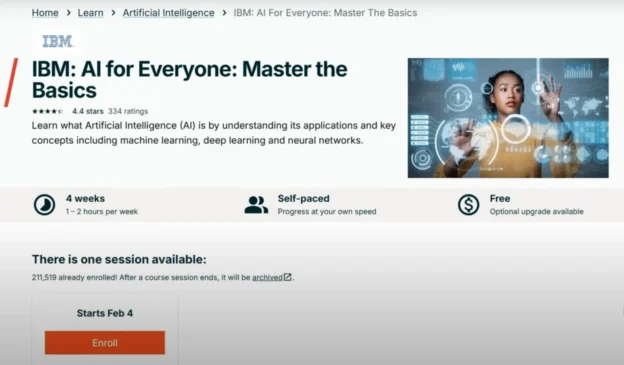
Step 11: Engage with AI Community — AI Roadmap 2025
The Power of Collective Intelligence
The AI landscape is characterized by its unprecedented pace of innovation. To stay relevant and motivated, becoming part of an active community is not just beneficial; it’s essential.
- Community is Everything: When people with a common passion, especially for AI, gather, it supercharges motivation, provides solutions when you’re stuck, celebrates your successes, and sparks new ideas you might never have considered.
- Geek Academy: This community is designed precisely for this purpose – to share AI knowledge, showcase creations, and help each other out. It provides a platform to stay updated with the latest AI news, connect with experts, and access carefully curated educational materials.
- Continuous Learning:The AI industry grows faster than you can blink. New tools, models, and technologies emerge daily. Being part of a community ensures you’re always on the cutting edge, getting immediate access to breaking news and insights.
Step 12: Practical Advice: Apply Your AI Skills in the Real World
Monetizing Your AI Know-How — AI Roadmap 2025
Theory is important, but practical application is where your AI skills truly solidify and can start yielding results. Don’t get stuck in “book mode” forever!
| Action | Description |
| Build Real-World Projects | Once you feel confident, start building—even small projects count. The hands-on experience of creating, debugging, and iterating provides invaluable learning. Follow along with video tutorials for practical reinforcement. |
| Analyze Job Postings | Regularly review AI job descriptions to understand in-demand skills. This helps you prioritize your learning (e.g., cloud platforms like AWS/GCP and frameworks like TensorFlow, PyTorch, and scikit-learn). |
| Prompt Engineering | Learn to craft precise, effective prompts for large language models (LLMs). Prompt engineering is becoming a vital skill and could be the most accessible entry point into AI careers. |
| Explore Beyond Python | While Python is essential, branching into other languages can deepen your understanding. Consider learning basics of MATLAB (AI modeling) or C++ (lower-level insights into AI architecture). |
| Experiment with Diverse AI Tools/Models | Test various AI tools to understand their capabilities. Try video generators like RunwayML, Sora, Deep Artifacts, and NLP platforms like OpenAI Playground or Hugging Face Transformers to broaden your exposure. |
AI Monetization Strategies — AI Roadmap 2025
| Monetization Strategy | Description |
| Selling Prompts | If you excel at prompt engineering, there’s a market for well-crafted prompts. |
| AI-Themed Products | Create and sell merchandise like t-shirts or hoodies with AI-generated designs. |
| Online Courses | Share your AI knowledge by creating and selling courses on platforms like Teachable, Udemy, or Gumroad. |
| Small Business Consulting | Help small businesses integrate AI tools (e.g., automation, chatbots, analytics) into their operations by offering consulting services. |
| Selling Trained Models | As you get more advanced, you can sell specifically trained models on sites like Model Depot. |
| Content Creation | Start a YouTube channel or blog about AI. |
| Entry-Level AI Jobs | Once you have a solid foundation, start applying for roles that match your skill set. |
Step 13: Final Tips: Consistency, Focus, and Embracing AI’s Diversity
Your Long-Term AI Success Strategy — AI Roadmap 2025
The world of AI is vast and constantly evolving. To avoid getting lost or overwhelmed, consistency and a clear plan are your best allies.
- Stay Consistent: Regular engagement, even if it’s just for a short period each day, is far more effective than sporadic bursts of intense study.
- Have a Solid Plan: Knowing exactly what resources you’re using and following a defined roadmap prevents you from getting lost in the “AI hype” and ensures you focus on what truly matters.
- Prioritize Essential Skills: Focus on foundational elements like cloud platforms (AWS, Google Cloud), core frameworks (TensorFlow, PyTorch, scikit-learn), and prompt engineering.
- Embrace Diversity: AI’s broad nature is actually a strength for learners. You can specialize in a specific type of AI (e.g., computer vision, NLP), become a developer, excel at prompt engineering, or even consult for companies. It’s hard to “do it wrong” when there are so many avenues to succeed.
- Leverage Community Support: A strong community provides motivation, answers to your questions, and invaluable networking opportunities. Don’t hesitate to join platforms like Geek Academy to connect with fellow AI enthusiasts and experts.
My Final Words –AI Roadmap 2025 :
The journey to mastering AI is exciting and highly rewarding. By defining your motivation, understanding the landscape, committing to hands-on practice, and leveraging the wealth of available resources and communities, you can confidently navigate the world of artificial intelligence and position yourself for success in 2025 and beyond.
What’s your first step going to be? Share your thoughts in the comments below!
Find more AI learning tutorials here !

